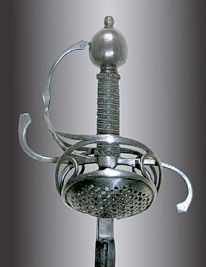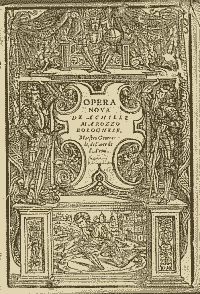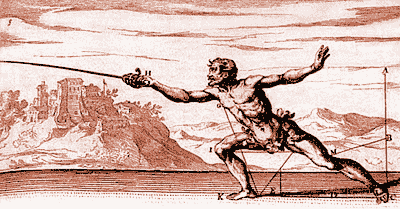|
|
|||||||
|
The adoption of the matchlock and wheellock puts an end to the full suit of armor (although it was still used in ceremonial).The knightly harness was now a liability, and with its demise came the decline of weapons designed to combat it: the mace, the war hammer and swords whose efficacy depended as much on percussion as on edge. A lighter, faster blade became both feasible and necessary.
The name rapier is thought to have derived from the Spanish espada ropera, “sword of the robes.” Possibly, the name has French origins; a French document of 1474 references an espée rapière. Either way, the term rapier was in common use throughout Europe by the end of the 15th century. The rapier’s history, employment, and development is rich and detailed, probably more so than any other bladed weapon in history.
The rapier blade was originally broad: usually an inch and a quarter wide, and its hilt still had stout, straight quillons. The necessity of accurately directing the point led swordsmen to slip their forefinger over the quillon for greater control. Soon (probably after numerous untimely losses of the protruding digit!) rings were added to the quillon. Since armored gauntlets were no longer in use, further protection for the hand was needed. The hilt gained a knuckle bow, and curved bars grew out of the quillons and rings of the anneau to enclose the hand in a metal cage. The swept hilt was now fully developed. In the late 1500s, the rapier underwent a subtle alteration. The open space in the rings of the large anneau were often filled in with decorative grillwork or shells - a design known as the Pappenheimer, named after German General Gottfried Heinrich, Graf zu Pappenheim. This weapon often had a rather wide blade, since it evolved partially as a military sword. By the early 1600s, the first cup-hilt rapiers had begun to appear. The swept hilt was replaced by a metal bowl, often 3 to 4 inches deep, inside which was the ricasso, flanked by pas d'âne (a ring-shaped guard). The knuckle bow was preserved, and the quillons became straight and often quite wide. This final form persisted until the early 1700s, especially in the hands of the Spaniards.
Cup Hilt Rapier
The history of warfare shows a constant dynamic between offense and defense. Since armor was no longer a consideration, and the rapier's design allowed for a much wider range of movement, the new competition became one of vying philosophies of defense, or, as the term evolved, "fence." Initially, the rapier was used like its medieval predecessor: as a cutting weapon. The first important book on rapier technique was the Opera Nova, written in 1536 by Achillio
The lunge was developed, which led to a stance that led with the right foot. This side stance, reducing the visible target area, eventually led to the abandonment of the off-hand weapon. Vincentio Saviolo was the first master to insist on the total superiority of the point, which led to the narrowing of the blade. Since the rapier no longer possessed the weight to cut by percussion, the draw cut was used. In that technique, the blade was placed against the target and rapidly pulled back under pressure, creating a slicing action that often involved a fair length of the overall edge. During that period, it was not uncommon for blades to exceed 40 inches in length. The art of fence also flourished in Germany, France and Spain, although Italian masters did most of the work that significantly advanced the art of fence and hence the design of the rapier. In England, where a 13th-century law forbade the establishment of schools of fence, and the social status of a fencing instructor was on a par with vagabonds and actors, the atmosphere was less conducive to the advancement of the art.
Illustration from the renaissance rapier's manual
One of the significant social aspects of the rapier was its status as a "civilian" weapon. Prior to the Renaissance, the sword was a symbol of the knight. With the rise of an affluent merchant class, the sword was now used by the upwardly mobile. Since a gentleman was expected to be capable of defending his honor, the carrying of a weapon was a fashion statement of his professed gentility. Eventually, the evolution of complex swordplay demanded the lightest, fastest possible weapon. The cup hilt's component parts - the quillons, cup, knucklebow and pas d'âne - all shrank down to the most perfunctory size possible. The blade itself became much shorter, with a deeply indented fuller. The result was the "small sword," a weapon that eclipsed the rapier completely in the 1700s. The smallsword was far easier to accommodate as a fashionable article of clothing, yet was still a formidable gentlemanly weapon with which to repel the attentions of footpads when returning from an evening's revels in Covent Garden.
|
|||||||
|
|
|||||||



